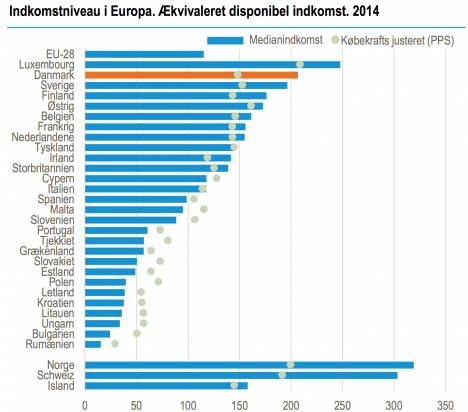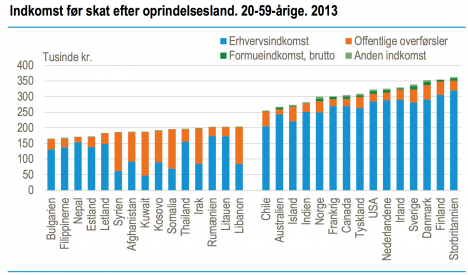Danes' buying power lags behind their incomes

Danes have the second-highest average income in the EU but Denmark’s high prices mean that their purchasing power is overtaken by both Swedes and Austrians. A new report also reveals major income differences among Denmark's immigrant groups.
A new report from Statistics Denmark reveals that only Luxembourgers take home higher post-tax incomes than the Danes. But once national price levels enter the picture, Danes’ purchasing power is outpaced by both Swedes and Austrians, who can get more for their money despite their lower incomes.
The average Dane earned 206,800 kroner ($31,000; 27,700 euros) after taxes in 2014, significantly higher than the EU-28 average of 115,400 kroner ($17,300; 15,500 euros). Among EU members, only Luxembourg had a higher disposable income level, although non-EU members Switzerland and Norway were also both ahead of Denmark.
But the picture for Danes is less rosy when one looks at purchasing power. Although Danes earn more than their Swedish neighbours, they also contend with a higher cost of living.
“Denmark is also more expensive to live in than Sweden. Before the correction for purchasing power, the median income was 5.2 percent higher in Denmark. After the correction, it was 2.9 percent lower in Denmark,” the report stated.
See also: Danes pay world's highest Netflix price
Austrians also leapfrog Danes when incomes are adjusted for purchasing power, with wage earners in Finland, Belgium, France, the Netherlands and Germany not far behind.

Chart showing average incomes (blue) and purchasing power (green dot). Source: Statistics Denmark
Still, the report comparison left no doubt that Danes are among the most well-off Europeans.
“The medium income in Denmark, after income taxes are paid and the figure is corrected for household size, is around 13 times higher than in Romania and twice as high as in Spain,” Statistics Denmark wrote in its report.
In addition to comparing Danes’ financial situation with their European neighbours, the Statistics Denmark report also shows significant differences in the earning power of Denmark’s immigrants.
Immigrants from the UK and their descendants were the highest earning group, with an average pre-tax income of 362,400 kroner even outpacing ethnic Danes (352,800 kroner). Bulgarians were the lowest-earning group, with an average income of 165,300 kroner.
Immigrants from non-Western countries were the most likely to receive a bulk of their income from public benefits. People from Kuwait received an average of 74 percent of their income in the form of public support, while Syrians received 66 percent and Afghans 50 percent.

Pre-tax income by country of origin. Source: Statistics Denmark
The Statistics Denmark report also includes an online tool allow wage earners in Denmark to see how their incomes compare with the rest of the country. The wage test can be accessed here, in Danish.
Comments
See Also
A new report from Statistics Denmark reveals that only Luxembourgers take home higher post-tax incomes than the Danes. But once national price levels enter the picture, Danes’ purchasing power is outpaced by both Swedes and Austrians, who can get more for their money despite their lower incomes.
The average Dane earned 206,800 kroner ($31,000; 27,700 euros) after taxes in 2014, significantly higher than the EU-28 average of 115,400 kroner ($17,300; 15,500 euros). Among EU members, only Luxembourg had a higher disposable income level, although non-EU members Switzerland and Norway were also both ahead of Denmark.
But the picture for Danes is less rosy when one looks at purchasing power. Although Danes earn more than their Swedish neighbours, they also contend with a higher cost of living.
“Denmark is also more expensive to live in than Sweden. Before the correction for purchasing power, the median income was 5.2 percent higher in Denmark. After the correction, it was 2.9 percent lower in Denmark,” the report stated.
See also: Danes pay world's highest Netflix price
Austrians also leapfrog Danes when incomes are adjusted for purchasing power, with wage earners in Finland, Belgium, France, the Netherlands and Germany not far behind.

Chart showing average incomes (blue) and purchasing power (green dot). Source: Statistics Denmark
Still, the report comparison left no doubt that Danes are among the most well-off Europeans.
“The medium income in Denmark, after income taxes are paid and the figure is corrected for household size, is around 13 times higher than in Romania and twice as high as in Spain,” Statistics Denmark wrote in its report.
In addition to comparing Danes’ financial situation with their European neighbours, the Statistics Denmark report also shows significant differences in the earning power of Denmark’s immigrants.
Immigrants from the UK and their descendants were the highest earning group, with an average pre-tax income of 362,400 kroner even outpacing ethnic Danes (352,800 kroner). Bulgarians were the lowest-earning group, with an average income of 165,300 kroner.
Immigrants from non-Western countries were the most likely to receive a bulk of their income from public benefits. People from Kuwait received an average of 74 percent of their income in the form of public support, while Syrians received 66 percent and Afghans 50 percent.

Pre-tax income by country of origin. Source: Statistics Denmark
The Statistics Denmark report also includes an online tool allow wage earners in Denmark to see how their incomes compare with the rest of the country. The wage test can be accessed here, in Danish.
Join the conversation in our comments section below. Share your own views and experience and if you have a question or suggestion for our journalists then email us at [email protected].
Please keep comments civil, constructive and on topic – and make sure to read our terms of use before getting involved.
Please log in here to leave a comment.